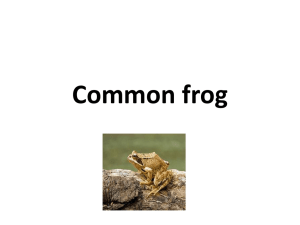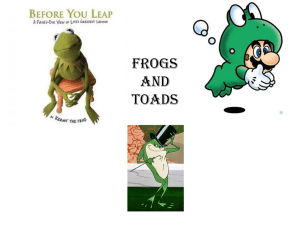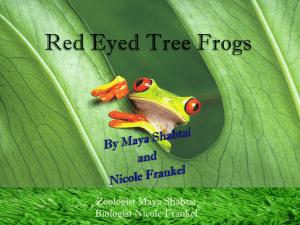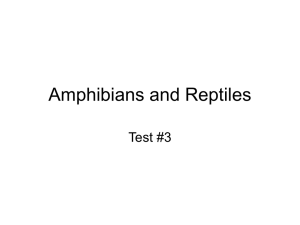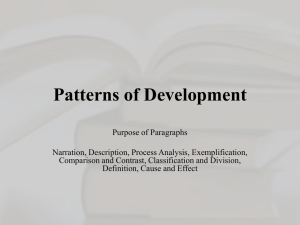Click to Power point presentation - Frogs in space
advertisement
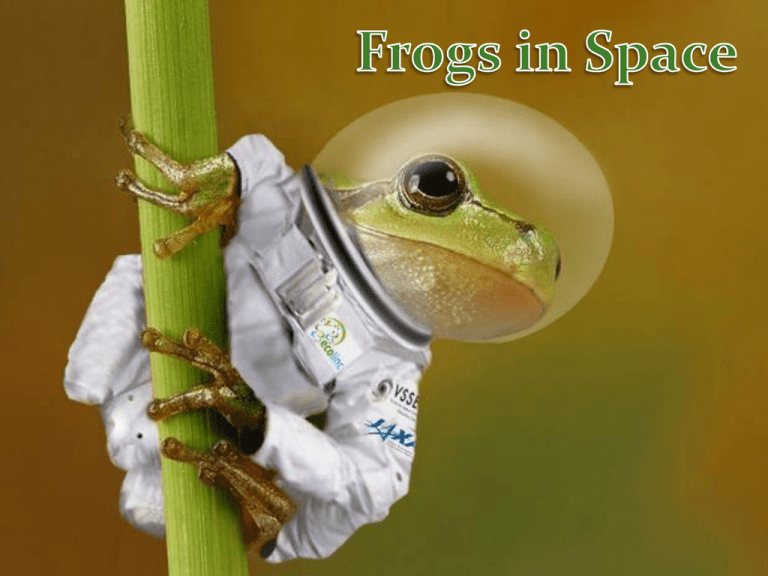
Frogs have been used in space research a number of times in the past. We will look at two different experiments In November 1970 NASA launched the Orbiting Frog Otolith spacecraft. This spacecraft carried two bullfrogs into orbit to study the effect of microgravity on the frog’s vestibular system. The orbiting frog otolith experimental package Bullfrogs were used because their inner ear otolith organs and labyrinths are very similar to humans. Also, because the frogs are amphibians they could survive in air for prelaunch preparation and then in water during the flight. Electrodes implanted in the frog’s vestibular nerves measured the reaction of the vestibular system to microgravity. Through the use of a centrifuge the frogs were subjected to 1 ‘g’ and the difference measured. This experiment provided vital information for our understanding of space motion sickness and disorientation. We will be focusing on the Frogs in Space (FRIS) experiment performed by Japanese scientists aboard the Mir Space Station. In December 1990 six adult Japanese tree frogs (an aboreal species) were sent to the Mir Space Station for 8 days to observe and record their behaviour in microgravity. One of the Japanese scientists involved in the FRIS experiment, Assoc. Prof. Izumi-Kurotani, has kindly shared her results and pictures with you. Frogs and other amphibians are interesting specimens to study in microgravity because they were the first creatures to leave the water and live on land supporting their weight on their legs. Frogs begin life as tadpoles in water and become terrestrial after a metamorphosis. Because air is about 1000 times lighter than water amphibians must make many physiological changes as they emerge from water. Frogs have many modes of locomotive behaviours walking, climbing, jumping and swimming. In microgravity, which mode of behaviour does a frog show? Some species of frogs and toads can experience microgravity environment on Earth because arboreal species may fall. It is interesting to compare the behaviours of arboreal and non arboreal species. The six frogs were housed separately in small compartments within a specially designed Life Support Box (LSB). The LSB provides air and room to move but also moisture which is important for a frog habitat. To decrease the effects of vibration and impact on the frogs during launch the LSB provided no room to move When on board the Space Station the frogs were released into a 2o litre clear glove box the inside moistened with a wet sponge. The frogs were observed through the window of the glove box everyday and were stimulated with food (meal worms) and their behaviour videoed. A group of control frogs on Earth were subjected to the same set of stimuli as those in orbit. First Japanese cosmonaut, Toyohiro Akiyama, observes the frogs How do you think frogs would react in microgravity? What do you think they would try and do when floating? Is it similar to anything they would experience on Earth? In space On Earth It was found that when the frogs floated in microgravity they took the same spread limbed pose as when they freefall from trees on Earth, very similar to a skydiver. This was thought to be a frogs natural reaction to a decrease in gravity felt during freefall and in space that was exactly what was happening to them! While the tree frog is an aboreal species and can experience freefall on Earth, non aboreal frogs do not experience freefall. How do you think a non aboreal species of frog would react in microgravity? The frogs also moved their legs in a motion similar to swimming though much bigger. It was discovered that these were the motions frogs used on Earth when upside down to turn their bodies the correct way up. The frogs also moved their limbs asymmetrically in an attempt to stabilise rotation. In microgravity, it was discovered that a species of non aboreal frog (Xenopus laevis) showed the same motions frogs use on Earth when upside down to turn their bodies the correct way up. The frogs moved their limbs asymmetrically in an attempt to stabilise rotation. Over 8 days in orbit the frogs slowly declined their attempts to jump within the box suggesting they were adapting to the microgravity environment. Frogs have extensive experience with microgravity when they jump from trees on Earth perhaps this helped them adjust to space conditions. In Space On Earth If the frogs stayed in orbit for a longer period, maybe several months or years, do you think they would continue the same behaviour? In Space On Earth One strange behaviour noted was that the frogs would bend their heads backward strongly when sitting on surfaces. This posture is only displayed on Earth when the frogs are retching or vomiting. This raised the possibility that perhaps the frogs were experiencing Space Motion Sickness! All six frogs returned alive to Earth and were observed directly after landing and over the next 12 hours to observe their readaption to the 1 ‘g’ environment. The flight frogs displayed different posture and movement to the Earth control frogs. The differences in behaviour began to fade and within 12 hours the space frogs displayed completely normal behaviour showing their readaption to the 1 ‘g’ environment. The Japanese Experimental Module, Kibo, has just been docked with the ISS. Using what you have learned about frogs, animal habitats in space and ethics, imagine you have been asked to propose an experiment to determine whether we can use frogs as an indicator of a healthy environment in space.


